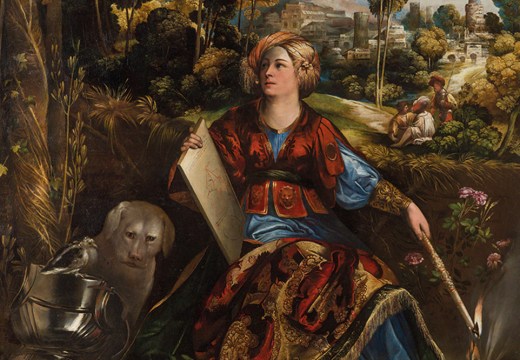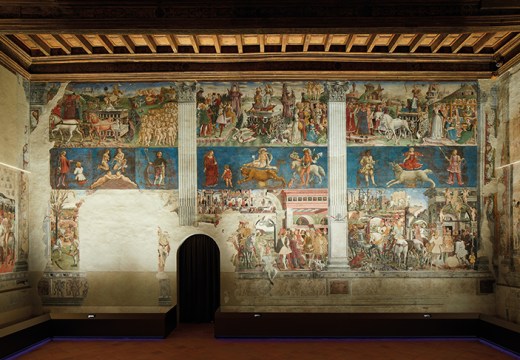The Camerino d’Alabastro created for Duke Alfonso I d’Este of Ferrara is thought to have been one of the most splendid and complex commissions of the Renaissance. It housed a group of extraordinary bacchanals, including Giovanni Bellini and Titian’s Feast of the Gods (National Gallery of Art, Washington, D.C.) and Titian’s Bacchus and Ariadne (National Gallery, London), Andrians and The Worship of Venus (both in the Prado). These riveting pagan narratives, brilliantly coloured and animated, are justly celebrated. Less well known is the fact that the camerino was also home to a painted frieze, above the narrative paintings, by Dosso Dossi (c. 1487–1542), who also supplied a bacchanal. The frieze illustrated the story of Aeneas, the mythical founder of Rome and hero of Virgil’s epic poem, the Aeneid, and originally there were 10 paintings in the sequence he delivered. An exhibition at the Galleria Borghese in Rome (until 11 July) has undertaken the fascinating challenge of reconstructing this frieze.
By any measure, Dosso Dossi was a peculiar artist. Born in Ferrara, he travelled around northern Italy and stylistically his work hovers somewhere between that of Giorgione in Venice and Raphael in Rome. Yet this description does little credit to his idiosyncratic paintings, which often depict intensively expressive, other-worldly figures, set amid lush landscapes and rendered in high-key colours. His contributions to the Camerino d’Alabastro, which date from the early 1520s, amply demonstrate these qualities.
Seven paintings in the Frieze of Aeneas have been identified, and five of these are shown in the Galleria Borghese. They have come from the Louvre Abu Dhabi, the Prado, the National Gallery of Art in Washington, D.C. and a Roman private collection. Those in the Barber Institute in Birmingham and the National Gallery of Canada are not present, although all are illustrated in the useful catalogue.

Two Legendary Episodes from Aeneid: The Cretan Plague (detail; c. 1518), Dosso Dossi. Louvre Abu Dhabi
The display on the top floor of the Galleria shows the paintings from the frieze a little above normal viewing height. They would originally have been installed quite a lot higher in the camerino – which must have made it hard to fully appreciate the complex narratives they contain and the nuances of Dossi’s episodic storytelling. In The Cretan Plague, for instance – which shows how the Trojans encountered a terrible epidemic that afflicted men and animals – Dossi depicted dying figures at the lower right, along with agonised attendants who cover their faces, fearful of contracting the disease and repelled by its stench.

Journey to the Underwold (1520–21), Dosso Dossi. Collezione Marisela Federici
Perhaps the greatest revelation is the painting from a private collection which shows Aeneas’ Journey to the Underworld, where he was led by the Sibyl. Published in 2004 and exhibited for the first time here, it is an intriguing, dark and hellish scene, with monsters, vignettes of torture and depravity and a number of hybrid creatures worthy of Hieronymus Bosch. These nocturnal visions would have created a dramatic foil for the other works we know to have been in the camerino; although these sometimes touch on menacing themes, they are broadly more festive in appearance.
The bacchanals in the camerino left Ferrara when it devolved to the Papal States. The Frieze of Aeneas, however, remained in situ until 1608, at which point it became part of the collection of Cardinal Scipione Borghese. This explains why this intriguing reconstruction project is being undertaken in the context of his magnificent Roman villa. Dosso Dossi’s wider ambitions and the range of work he undertook are also demonstrated in the display by the inclusion near the frieze of a group of much larger and more splendid canvases depicting Apollo and Daphne, Melissa and Saints Cosmos and Damian.

The Sorceress Circe or Melissa (1518), Dosso Dossi. Galleria Borghese, Rome. Photo: Mauro Coen; courtesy Galleria Borghese
The exhibition is tantalising. It nudges us closer to a sense of what Alfonso D’Este’s camerino might have looked like, but there are secrets yet to be revealed. Three pictures are still to be located and the ordering of the scheme is a matter of debate. The field remains open for iconographers, picture hunters and all those curious about this glorious Renaissance conundrum.
‘Dosso Dossi. The Aeneas Frieze’ is at the Galleria Borghese, Rome until 3 July.
Unlimited access from just $16 every 3 months
Subscribe to get unlimited and exclusive access to the top art stories, interviews and exhibition reviews.














![Masterpiece [Re]discovery 2022. Photo: Ben Fisher Photography, courtesy of Masterpiece London](http://www.apollo-magazine.com/wp-content/uploads/2022/07/MPL2022_4263.jpg)
It’s time for the government of London to return to its rightful home